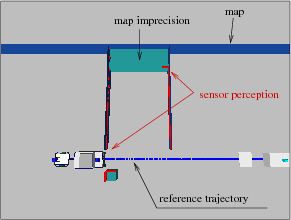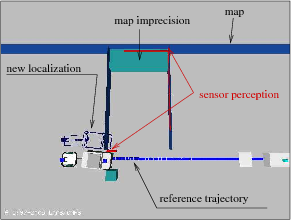Docking for
non-holonomic systems
|
Top
|
|
Precise parking for
non-holonomic systems in cluttered environments is
a very challenging issue. Kinematic and environment complexity make
fast path re-planning
impractical. We have used the Non-Holonomic Path Deformation method in
this context. We deform a planned trajectory so that it reaches a
docking configuration
defined as a desired sensor perception. The robots avoids obstacles at
the same time.
|
 |
The docking
configuration is defined as
the position of the sensor where the actual sensor perception best
matches the desired sensor perception (called docking pattern). Notions are
similar to those of visual-servoing.
|
|
Some movies of docking tasks with a SICK sensor:
|
(we use GDHE for the
3D real-time display of
robots data)
|
Simulated environment
-
robot Hilare2 with a
trailer, parking between 2 boxes, with undefined positions and width: AVI
516 Ko, AVI 503 Ko, AVI
658 Ko.
|
Real Experiments
|
Some videos are time
rescaled
|
|
Robot Hilare2 with a trailer,
with a docking pattern defined
relatively to the trailer, parking:
- between 2 boxes (MP4 2790 Ko).

- between the boxes again, but this time they are shifted
when the robot can not see them (MP4 5006 Ko).
- then going under a desk (MP4 5433 Ko).
- then between the boxes again (MP4 5463 Ko).
- then coming back under the desk, which is shifted when the
robot can not see it (MP4 5806 Ko).
- finally, precise parallel parking with respect to the
trailer (MP4 5289 Ko).
|
A document in French presents
the notions of likelihood and of Mahalanobis distance, which are
commonly used in estimation. In the context of a docking task, we use
these notions to find the docking pattern among the perceived features
and to evaluate the likelihood of the docking position
compared to the planned final configuration.
The paper [5] presents this
work.
|






 The non-holonomic
path deformation
method has been implemented on robot CyCab, from INRIA Rhone-Alpes. (
The non-holonomic
path deformation
method has been implemented on robot CyCab, from INRIA Rhone-Alpes. (






